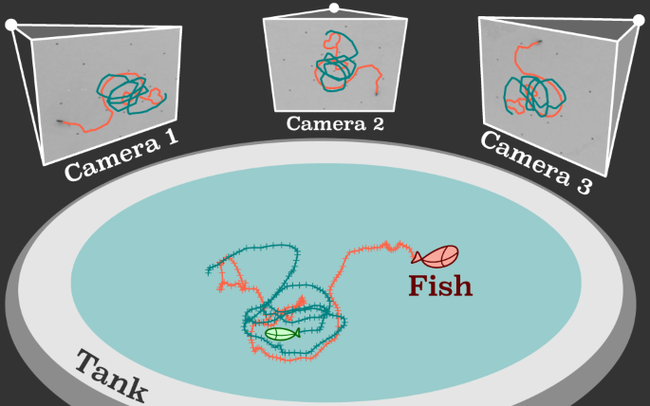 Zebrafish constitute a convenient laboratory–based biological system for studying collective behavior. It is possible to interpret a group of zebrafish as a system of interacting agents and to apply methods developed for the analysis of systems of active and even passive particles. Here, we consider the effect of group size. We focus on two– and many–body spatial correlations and dynamical order parameters to investigate the multistate behavior. For geometric reasons, the smallest group of fish which can exhibit this multistate behavior consisting of schooling, milling and swarming is three. We find that states exhibited by groups of three fish are similar to those of much larger groups, indicating that there is nothing more than a gradual change in weighting between the different states as the system size changes. Remarkably, when we consider small groups of fish sampled from a larger group, we find very little difference in the occupancy of the state with respect to isolated groups, nor is there much change in the spatial correlations between the fish. This indicates that fish interact predominantly with their nearest neighbors, perceiving the rest of the group as a fluctuating background. Therefore, the behavior of a crowd of fish is already apparent in groups of three fish.
Zebrafish constitute a convenient laboratory–based biological system for studying collective behavior. It is possible to interpret a group of zebrafish as a system of interacting agents and to apply methods developed for the analysis of systems of active and even passive particles. Here, we consider the effect of group size. We focus on two– and many–body spatial correlations and dynamical order parameters to investigate the multistate behavior. For geometric reasons, the smallest group of fish which can exhibit this multistate behavior consisting of schooling, milling and swarming is three. We find that states exhibited by groups of three fish are similar to those of much larger groups, indicating that there is nothing more than a gradual change in weighting between the different states as the system size changes. Remarkably, when we consider small groups of fish sampled from a larger group, we find very little difference in the occupancy of the state with respect to isolated groups, nor is there much change in the spatial correlations between the fish. This indicates that fish interact predominantly with their nearest neighbors, perceiving the rest of the group as a fluctuating background. Therefore, the behavior of a crowd of fish is already apparent in groups of three fish. Zebrafish constitute a convenient laboratory–based biological system for studying collective behavior. It is possible to interpret a group of zebrafish as a system of interacting agents and to apply methods developed for the analysis of systems of active and even passive particles. Here, we consider the effect of group size. We focus on two– and many–body spatial correlations and dynamical order parameters to investigate the multistate behavior. For geometric reasons, the smallest group of fish which can exhibit this multistate behavior consisting of schooling, milling and swarming is three. We find that states exhibited by groups of three fish are similar to those of much larger groups, indicating that there is nothing more than a gradual change in weighting between the different states as the system size changes. Remarkably, when we consider small groups of fish sampled from a larger group, we find very little difference in the occupancy of the state with respect to isolated groups, nor is there much change in the spatial correlations between the fish. This indicates that fish interact predominantly with their nearest neighbors, perceiving the rest of the group as a fluctuating background. Therefore, the behavior of a crowd of fish is already apparent in groups of three fish.
Zebrafish constitute a convenient laboratory–based biological system for studying collective behavior. It is possible to interpret a group of zebrafish as a system of interacting agents and to apply methods developed for the analysis of systems of active and even passive particles. Here, we consider the effect of group size. We focus on two– and many–body spatial correlations and dynamical order parameters to investigate the multistate behavior. For geometric reasons, the smallest group of fish which can exhibit this multistate behavior consisting of schooling, milling and swarming is three. We find that states exhibited by groups of three fish are similar to those of much larger groups, indicating that there is nothing more than a gradual change in weighting between the different states as the system size changes. Remarkably, when we consider small groups of fish sampled from a larger group, we find very little difference in the occupancy of the state with respect to isolated groups, nor is there much change in the spatial correlations between the fish. This indicates that fish interact predominantly with their nearest neighbors, perceiving the rest of the group as a fluctuating background. Therefore, the behavior of a crowd of fish is already apparent in groups of three fish.
